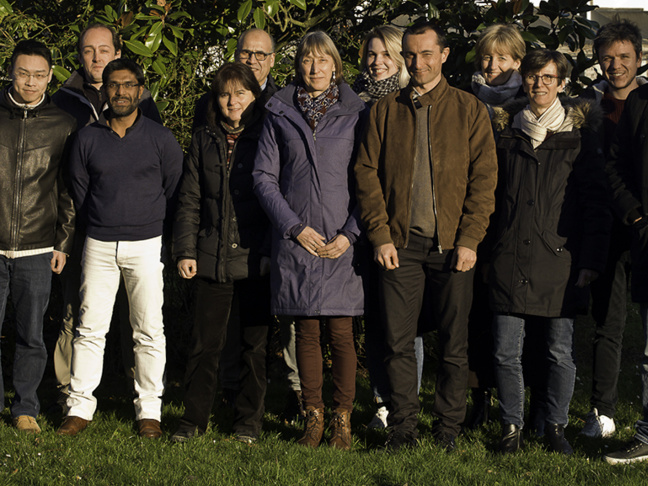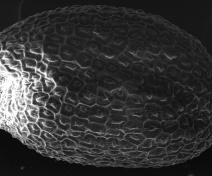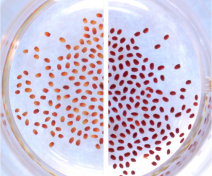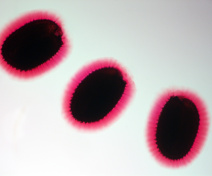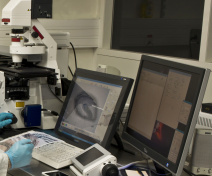PHYGERM team research aims to understand the molecular mechanisms underlying the key factors pre- or post- harvest that influence germination capacity and seedling vigour, with a focus on adaptive responses to environmental constraints.
Scientific objectives
Seeds are the major component of feed and food and the majority of crops are produced from seeds. This means that as the world population increases so does the demand for seed. Sub-optimal seed performance can lead to major economic losses and food supply shortages and this is set to be aggravated by climate change as abiotic constraints negatively impact seed quality. Our aim is to decrypt the central mechanisms that mediate germination while exploring their potential in applications to enhance seed performance. In particular, we seek to understand how seeds interpret and respond to environmental variations pre- and post-harvest.
Seeds are the major component of feed and food and the majority of crops are produced from seeds. This means that as the world population increases so does the demand for seed. Sub-optimal seed performance can lead to major economic losses and food supply shortages and this is set to be aggravated by climate change as abiotic constraints negatively impact seed quality. Our aim is to decrypt the central mechanisms that mediate germination while exploring their potential in applications to enhance seed performance. In particular, we seek to understand how seeds interpret and respond to environmental variations pre- and post-harvest.
We apply a multidisciplinary approach using molecular genetics, multi-omics, statistical learning, bioinformatics, biochemistry, histology and physiology to study seeds from a wide range of species such as oilseed crops (e.g. camelina, cabbage), legumes (e.g. bean, lentil), cereals (e.g barley, maize) and vegetable crops (e.g. tomato and lettuce). Nonetheless, the majority of our fundamental research focuses on the genetic model Arabidopsis.
Research areas
Our projects cover 3 main research areas:
Control of seed germination
Mature dry angiosperm seeds are formed of three genetically distinct compartments whose structure and properties enable them to fulfil different functions:
- The zygotic embryo that will develop into the future plant,
- A triploid endosperm a nutritive tissue
- The seed coat, a diploid maternal tissue derived from one or two protective ovule integuments.
Mature dry angiosperm seeds are formed of three genetically distinct compartments whose structure and properties enable them to fulfil different functions:
- The zygotic embryo that will develop into the future plant,
- A triploid endosperm a nutritive tissue
- The seed coat, a diploid maternal tissue derived from one or two protective ovule integuments.
The characteristics of these different compartments and their interactions are determined by molecular and mechanical factors. We are characterizing a variety of mechanisms that act in different compartments and affect the germination, dormancy and lifespan of seeds as well as seedling vigour. In particular, the signalling networks for hormones such as abscisic acid, gibberellins and salicylic acid, the regulation of gene expression, protein translation and modification and the production and physiological functions of polysaccharides and flavonoids accumulated in the seed coat.
Effect of the mother plant environment on germination traits
The environmental signals perceived by the mother plant have a strong influence on traits acquired during seed development and can have long-term repercussions with effects being visible months and years after dispersal. We are using multi-omics to decipher the molecular switchboards that determine the molecular mechanisms induced by environmental factors such as temperature and water deficit and how these affect seed fate from development, through dispersal, storage and germination to seedling development.
The environmental signals perceived by the mother plant have a strong influence on traits acquired during seed development and can have long-term repercussions with effects being visible months and years after dispersal. We are using multi-omics to decipher the molecular switchboards that determine the molecular mechanisms induced by environmental factors such as temperature and water deficit and how these affect seed fate from development, through dispersal, storage and germination to seedling development.
Translational seed biology
We are exploiting results from our research in innovative methodologies to maximise seed performance and germination potential. For example, we are developing seed treatment technologies such as priming and quality control assays using markers and biosensors.
We are exploiting results from our research in innovative methodologies to maximise seed performance and germination potential. For example, we are developing seed treatment technologies such as priming and quality control assays using markers and biosensors.

Leader:
Helen North
